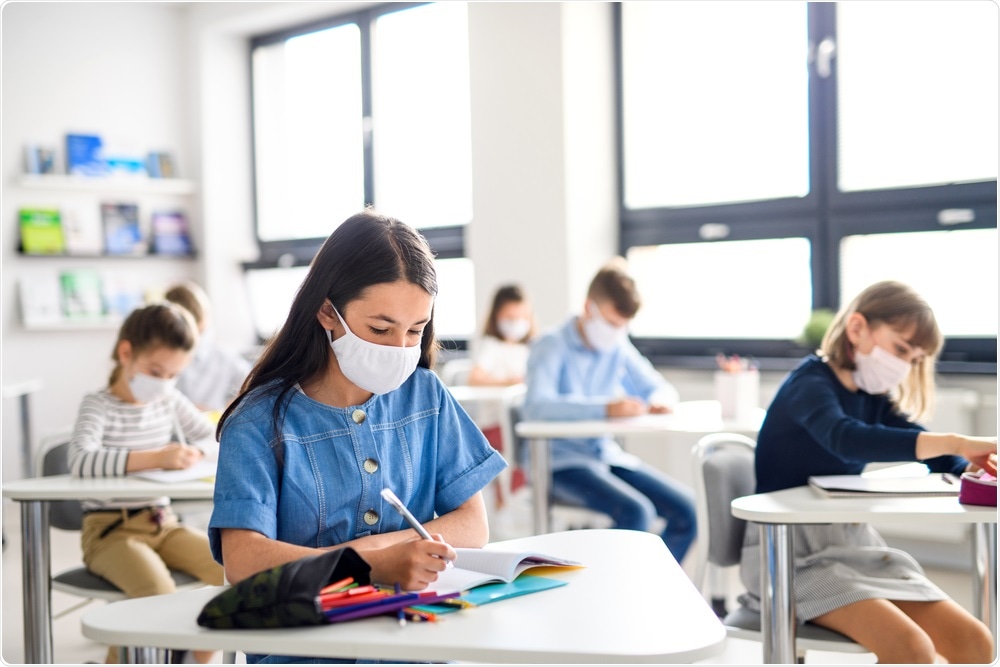In general, children are less frequently affected by the coronavirus disease 2019 (COVID-19) as compared to adults. The infection rates of severe acute respiratory syndrome coronavirus 2 (SARS-CoV-2), which is the virus responsible for COVID-19, in children are not well known. Whether SARS-CoV-2 infection rates in children reflect community transmission, these rates differ between younger children and adolescents, or if the adult infection rates impact the prevalence of SARS-CoV-2 infection in children, are all open questions that require further investigation.
A population-based study conducted in Belgium assesses the prevalence of SARS-CoV-2 antibodies, which is otherwise known as seroprevalence, in a representative sample of children from regions with high and low community transmission.
 Study: Age-dependent seroprevalence of SARS-CoV-2 antibodies in school-aged children from areas with low and high community transmission. Image Credit: Halfpoint / Shutterstock.com
Study: Age-dependent seroprevalence of SARS-CoV-2 antibodies in school-aged children from areas with low and high community transmission. Image Credit: Halfpoint / Shutterstock.com
Importance of seroprevalence studies
Large regional differences in SARS-CoV-2 infection rates have been observed across countries, states, counties, and municipalities. In fact, even a less densely populated country will have large regional differences in infection rates.
To date, there have been few reports on SARS-CoV-2 seroprevalence in children. Some studies conducted in Spain, the United States, and Switzerland indicate that seroprevalence rates in children are generally lower than those seen in adults.
The Swiss study, for example, found that seroprevalence in younger children is significantly lower than in adolescents when compared to adults. This finding therefore establishes that the risk of infection is lower in younger children. However, as higher age groups are studied, the infection rates more closely resemble those seen in adults.
Data on infection rates in children can guide policymakers in deciding what mitigation measures should be implemented to reduce the transmission of SARS-CoV-2 within the society, particularly in school settings where children are more likely to be exposed to and spread this virus.
Seroprevalence data collection
In the current study, two municipality regions in Belgium were selected. These regions include Alken, Belgium, which was had the highest SARS-CoV-2 infection rates in this nation, as well as Pelt, Belgium, which has consistently had an infection rate below the national average.
The children included in the current study were divided into two age groups, which included primary (6-12 years) and secondary (12-15 years) aged students.
A total of 360 children, equally distributed within both municipalities, were randomly chosen for the study. Caregivers of the children submitted an online questionnaire that provided information related to their sociodemographic characteristics, health status, and risk factors for infection.
Seroprevalence within blood samples was tested using a commercial semi-quantitative enzyme-linked immunosorbent assay (ELISA). Statistical analyses were employed for data interpretation.
Seroprevalence and risk factors
Primary school children between the ages of 6 and 12 were not found to exhibit any seroprevalence in Pelt; however, this rose to 8.9% when this age group was studied in Alken. Comparatively, 13.3% of secondary school children in Pelt had seroprevalence, whereas 15.4% of children within this age group in Alken had seroprevalence.
No significant gender differences among seropositive children were found in this study.
Of the 294 children who reported no infection prior to this study, 7.5% were found to be seropositive. Additionally, of the 43 children whose parents were not sure whether their child had been infected, 16.3% were found to be seropositive.
Before the study, 60.1% of the children had reported certain symptoms like fever, cough, difficulty breathing, loss of taste and smell, headache, runny nose, sore throat, ear pain, muscle pain or weakness, stomach pain, diarrhea, nausea, rash, or painful eyes. Even so, none of the children experienced severe symptoms that required hospitalization.
Apart from this data, the researchers also looked at possible risk factors associated with seropositivity. Children whose parents work in the healthcare sector with COVID-19 patients, for example, were more likely to be seropositive. Other risk factors include extracurricular activities for at least 1 hour per week and contact with individuals who tested positive for SARS-CoV-2.
In this study, the researchers do not find the following factors as a risk for seropositivity:
- Country of origin of the child
- Family structure
- Diversity of age groups in the family
- Number of individuals in the family
- Employment and education of parents
- Family income
Limitations of the study
The seroprevalence survey discussed here provides information regarding infection in the past; however, it provides no insight into the transmission dynamics. Studies investigating transmission dynamics are therefore required to support the decision-making process on appropriate mitigation measures for children.
The current study does not present data that can determine the exact age at which the rate of infections becomes comparable to that of adults. There is a possibility of selection bias in this study because when a family member or a close relative is infected, individuals are more willing to participate in such studies.
Implications of the study
The percentage of seropositive children in a low community transmission region like Pelt was found to be 4.4%, whereas the seropositive rate in a high community transmission region like Alken was reported to be 14.4%. This data demonstrates that seroprevalence in children reflects the local transmission of the virus in the community.
In the low transmission region, none of the primary school children tested were seropositive. Therefore, young children appear to be less susceptible in a community with a low circulation of SARS-CoV-2.